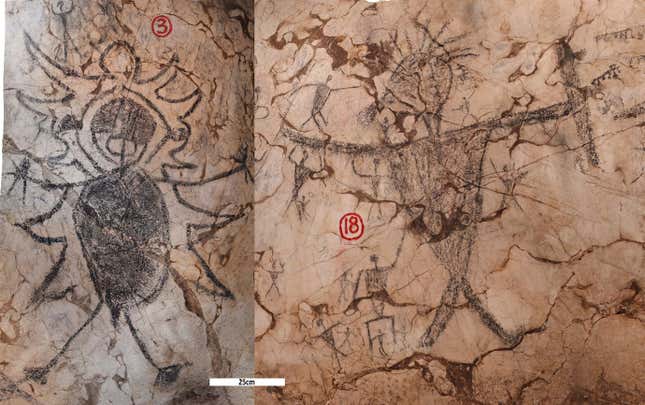Researchers recently dated charcoal drawings in Borneo’s Gua Sireh Cave to around the 18th century CE, giving a colonial context to the artwork.
Even Twitter Can’t Kill Twitter | Letter From the Editor
Gua Sireh is in Malaysian Borneo. The cave’s limestone walls are covered in hundreds of charcoal drawings depicting people (many in headdresses), knives, animals, and abstract designs. But interpretations of the scenes have been limited by researchers’ uncertainty about when they were made. The new team’s dating and analysis of two large human figures in the cave was published today in PLoS ONE.
“We had clues about their age based on subjects such as introduced animals, but we really didn’t know how old they were, so it was difficult to interpret what they might mean,” said Paul Taçon, an anthropologist at Griffith University in Australia and a co-author of the study, in a university release.
Gua Sireh contains at least 406 motifs and drawings that have been documented over the last 34 years, the researchers stated in the paper. Drawings in the cave range from about 4 inches (10cm) in height to nearly 5 feet (1.5m) tall; the two anthropomorphic figures dated by the team are the largest motifs in the cave.
The drawings were dated to between 1670 CE and 1830 CE, a period when the local Bidayuh people used the cave as refuge from territorial violence, much of it by Malay elites who controlled the region. The researchers believe their radiocarbon dates are the first made on Malaysian rock art.
“Black drawings in the region have been made for thousands of years,” said Jillian Huntley, co-lead on the research and also an anthropologist at Griffith University, in the same release. “Our work at Gua Sireh indicates this art form was used up to the recent past to record Indigenous peoples’ experiences of colonization and territorial violence.”
Researchers from Australia’s Griffith Centre for Social and Cultural Research has dated rock art elsewhere in southeast Asia; in 2021, researchers revealed that painting of pigs on the island of Sulawesi may be the oldest-known figurative artwork, clocking in at 43,900 years old.
The recent team noted other humanoid and anthropomorphic figures in the region have much older dates associated with them; one figure in the Penablanca Cave complex in the Philippines dates to roughly 3,500 years old, and a human figure in a cave on Sulawesi dates to about 1,500 years old.
In comparison, the figures in Gua Sireh are downright youthful. But that makes them all the more interesting: rock art was still a means of storytelling for the Bidayuh until the recent past. Mohammad Sherman Sauffi William, a curator at the Sarawak Museum and a Bidayuh descendent, said in the release that a group of Bidayuh held off 300 armed men from the cave in the early 1800s, allowing the rest of the tribe to escape through the cave’s rear.
“The figures were drawn holding distinctive weapons such as a Pandat which was used exclusively for fighting or protection, as well two short-bladed Parang Ilang, the main weapons used during warfare that marked the first decades of white rule in Borneo,” William said.
More documentation of these figures will help researchers understand their significance, especially when put in a chronological context. Not all rock art is ancient, and the modern stories are just as worth telling.
More: 40,000-Year-Old Rock Art Is Being Destroyed Due to Climate Change
























